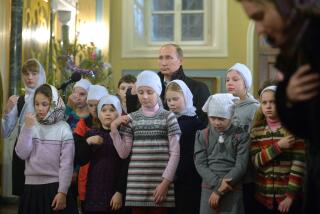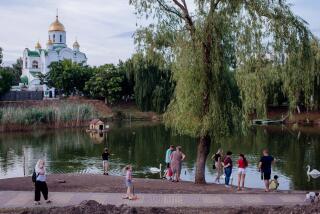The Past, and the West, Beckons to Kaliningrad
- Share via
KALININGRAD, Russia — Sitting at a terrace cafe in a district of sturdy old German houses, one could imagine oneself thrust back in time to old Prussia. It is an apt setting for Yuri Nushtayev, one of the backers of a drive to readopt this city’s original German name, Koenigsberg.
The long-haired graphic designer has no German roots. Like almost all of the other 950,000 residents of the Kaliningrad region, he is ethnically and linguistically Russian.
But, as the 32-year-old earnestly explained to a visitor, many members of his generation are looking for a new future for this outpost of Russia nestled up against the Baltic that may soon find itself marooned inside the European Union. That future has a direction: west.
And first stop in that direction is ending the Soviet practice of denying the city’s past.
Leningrad has gone back to calling itself St. Petersburg. Sverdlovsk has reverted to Ekaterinburg. But, as the Kremlin sees it, Kaliningrad is never to become Koenigsberg again.
It’s just one example of Moscow’s policy toward Kaliningrad that drives people such as Nushtayev crazy.
Kaliningrad is a name that honors an early Bolshevik and close associate of Josef Stalin. But this former Prussian capital was known to knights, merchants, writers, musicians, philosophers and seafarers as Koenigsberg for 700 years.
But to hear the response of federal authorities--”Madness!” is typical--it is as if Nushtayev and his friends seek to undo the Russian victory of World War II.
Suddenly, 57 years after being turned over to Stalin at Potsdam, and 11 years after it ceased being a closed Soviet district, Kaliningrad appears to be on everyone’s agenda. That’s because of the likely admission of Poland and Lithuania, its immediate neighbors, to the EU next year--which would make Kaliningrad a Russian island inside the EU’s borders.
Members of the State Duma, Russia’s lower house of parliament, fear that the rest of Europe will try to peel Kaliningrad away from Russia. European diplomats have their worries too, wrestling with how to protect the EU from smuggling and illegal migrants from the Russian enclave. Journalists and academics are intrigued by the question of how this little sliver of Russia, slightly larger than Connecticut, will fare within the united Europe.
Kaliningrad is a historical and geographic anomaly. Eight hundred miles from Moscow, its location between Poland and Lithuania leaves it cut off from the rest of Russia by three international boundaries.
Back when the Soviet empire stretched from the Elbe River to Vladivostok, that didn’t matter much. But now that the rest of the empire has receded, Kaliningrad has been left behind, as it were, high and dry.
During the Cold War, Kaliningrad’s territory and year-round harbor offered a useful protrusion into Europe for the Soviet military. Strangers weren’t allowed in for secrecy reasons, turning a region that always had thrived on commerce into a sealed box and a mystery even to its immediate Eastern Bloc neighbors.
After the Soviet Union fell, Kaliningrad opened up and crime and sleaze poured in; the region became as well known for its petty smuggling of vodka and cigarettes, abundant prostitutes, narcotics and AIDS as it was for buried amber, a semiprecious petrified resin used in jewelry, and its few surviving German cultural monuments.
With Kaliningrad on course to be surrounded by the azure flag of the EU, the problem for residents is likely to be sorting out their place and their identity.
Kaliningraders live closer to 10 European capitals than they do to Moscow. Some would argue that this city is closer in spirit too.
Old German postcards show Koenigsberg as it was--bustling streets crowded with stately burgher homes and shops, steepled churches, streets lined with trees and the main square dominated by a Gothic royal castle.
Today’s Kaliningrad center is unrecognizable. With the exception of the majestic red-brick cathedral, everything was destroyed during or after the war. Now, in the center, one sees wide streets lined with boxy, nondescript, Soviet-built apartment blocks, squat rows of kiosks for shopping, and empty wind-swept spaces where cars park and refuse collects.
Yet some Old World charm has managed to survive--alleys of trees and green parks planted with flower beds, and, on the edges of this city and in the countryside, sturdy prewar houses whose steep red-tile roofs flare out at the eaves (and occasionally are crowned by a voluminous stork’s nest).
Mere proximity to Western European values has imbued people in Kaliningrad with a more cosmopolitan, tolerant and compromising attitude, people here say.
“If you wanted to sum it up, Kaliningraders are more civilized than the rest of Russia,” said Sergei Pasko, a leader of the Baltic Republican Party. Behind him hung the red-white-and-blue flag with a golden compass star that he hopes one day will become the banner of an autonomous “Baltic Republic.”
It would be going too far to say that a large proportion of people in the region want independence. Even Pasko’s separatist party believes that there should be “association” with Russia.
But there are abundant signs that people here--as in many of Russia’s 89 republics and regions--chafe at what they see as callous and arbitrary decision-making in Moscow that does not always take into account their interests.
“So far the situation with separatism is hypothetical,” said Soloman I. Ginsburg, a member of the regional parliament. But sentiment for independence could grow in 10 years if Kaliningrad under Russian governance does not manage to close the gap in living standards with its European neighbors, he predicted.
“Obtaining a Mercedes will be a stronger motivating factor than the wish to look at Russian birch trees,” he said.
The most pressing problem facing Russia and Kaliningrad is the EU’s insistence that Poland and Lithuania, starting next July, impose visa requirements for people entering their territory from Russia.
Russian officials seemed caught by surprise and reacted indignantly. In tones that made some feel that he was making Soviet-style threats, Russian President Vladimir V. Putin denounced the EU’s proposal and said it would be “worse than the Cold War.”
He said Russia wouldn’t accept any situation in which someone from another country would determine whether a Russian citizen could travel from Russia proper to the Kaliningrad enclave. At first, Putin’s proposed solution was for sealed trains and/or a visa-free corridor across Lithuania and Poland to get around the problem.
But these proposals didn’t sit well with the EU. Now Russia seems to be asking the EU to adopt a very liberal no-visa-needed policy toward all Russians similar to the one the bloc has with Americans.
Last month, the sides began what is likely to be a drawn-out negotiating process in Brussels to find a compromise that protects the EU’s security while not--in the words of French President Jacques Chirac--”humiliating” Russia.
Visa worries are felt acutely these days in Kaliningrad. The EU policy would have “very grave consequences economically,” said Alexander S. Karetsky, a lifelong resident and now spokesman for the regional governor, Vladimir Yegorev, who happens to be the ex-commander of the Russian Baltic Fleet.
To an American visitor, Karetsky asked, “What if to travel from the main part of the United States to Alaska, you needed a visa from Canada? Wouldn’t that be ridiculous?”
Of course, even under the EU’s plan, people would still be able to travel freely to Russia by plane or ferry. But most people now go by car or bus. About two-thirds of Kaliningraders don’t even have passports, and to impose even a modest visa fee would be burdensome for people often earning less than $100 a month.
Even though the visa question is a difficult one, most people believe that Russia and the EU will eventually find a way to finesse the issue. For residents, it is vital, not so much because they need to travel back to Russia, but because their livelihood is linked to their Baltic Sea neighbors.
In other words, Kaliningrad is reverting to form.
Founded by crusading Teutonic knights who subdued (and virtually wiped out) the indigenous pagan tribes of the area, Koenigsberg in the Middle Ages was a member of the Hanseatic League, a federation of trading towns spread along the Baltic. Its port and its commerce brought riches to the city, making it one of the jewels of northeastern Europe.
In 1945, Koenigsberg and its surrounding area in what had been East Prussia was formally recognized by Allied leaders at Potsdam as belonging to the Soviet Union. The victorious Red Army was already there. Most of the German population had already fled or been killed, and the remnants would soon be roughly relocated to the Soviet occupation zone of Germany.
Nazi Germany was to be punished for its wartime aggression by losing East Prussia; Stalin decreed that Soviet citizens should move in and erase all memories of Prussia from this new Soviet territory.
Historic buildings, heavily damaged by the war, were torn down rather than restored. Streets and cities were renamed wholesale. In the countryside, collective farms supplanted baronial manors and feudal estates.
Yuri V. Kostyashof, a historian at Kaliningrad State University, says that Soviet authorities had an unofficial motto--”To erase the Prussian spirit from the land”--and that is why they were so avid to destroy anything that smacked of the city’s Germanic past.
Now he believes strongly that today’s Kaliningrad would benefit from an honest interpretation of its past and that the historical record of Koenigsberg would provide insights into today’s political discussions about the enclave’s future.
“Koenigsberg flourished only at times when it had good relations with its neighboring countries,” he said. “The openness of the Kaliningrad region to the outer world is the main guarantor of its prosperity. That is what history teaches.”
More to Read
Sign up for Essential California
The most important California stories and recommendations in your inbox every morning.
You may occasionally receive promotional content from the Los Angeles Times.













